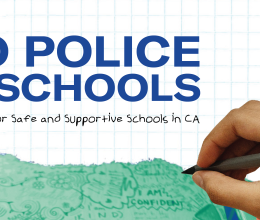
NEW TOOLS TO PREVENT BULLYING IN CALIFORNIA SCHOOLS
California Education Code Sections 234, 234.1, 234.2, 234.3 AND 234.5
A FACT SHEET FROM THE ACLU OF CALIFORNIA
What is Seth's Law?
"Seth's Law" is a new law that strengthens existing state anti-bullying laws to help protect all California public school students. Seth's Law requires public schools in California to update their anti-bullying policies and programs, and it focuses on protecting students who are bullied based on their actual or perceived sexual orientation and gender identity/gender expression, as well as race, ethnicity, nationality, gender, disability, and religion. Seth's Law went into effect on July 1, 2012.
Why did the California Legislature pass Seth's Law?
California law says that all public school students should have equal rights and opportunities. Yet many lesbian, gay, bisexual, transgender, and questioning students report that they experience significant bullying in California schools. And teachers, administrators, and other staff often fail to address the bullying when they see it. Seth's Law is named after a 13-year-old California student who tragically took his own life in 2010 after years of anti-gay bullying that his school failed to address.
AT A GLANCE: What does state anti-bullying law require school districts to do?
- Adopt a strong anti-bullying policy that specifically spells out prohibited bases for bullying, including sexual orientation and gender identity/gender expression.
- Adopt a specific process for receiving and investigating complaints of bullying, including a requirement that school personnel intervene if they witness bullying.
- Publicize the anti-bullying policy and complaint process, including posting the policy in all schools and offices.
- Post on the district website materials to support victims of bullying.
School Personnel Must Intervene
Seth's Law specifically contains the following requirement: "If school personnel witness an act of discrimination, harassment, intimidation, or bullying, he or she shall take immediate steps to intervene when safe to do so." (Education Code Section 234.1(b)(1))
Anti-Bullying Policy
Each school district is required to adopt a policy that prohibits discrimination, harassment, intimidation, and bullying that applies to all acts related to school activity or school attendance occurring within a school.
Under Seth's Law, the policy must specifically prohibit discrimination, harassment, intimidation, and bullying based on these actual or perceived characteristics: disability, gender, gender identity, gender expression, nationality, race or ethnicity, religion, and sexual orientation. Discrimination, harassment, intimidation or bullying directed at someone associated with a person or group with one or more of the listed actual or perceived characteristics is also prohibited. (Education Code Section 234.1(a))
Anti-Bullying Complaint Process
School districts must adopt a process for receiving and investigating complaints of discrimination, harassment, intimidation, or bullying. The process must include a timeline to investigate and resolve complaints and an appeals process for the complainant. All complaints are to remain confidential, as appropriate, and schools are required to protect complainants from retaliation. (Education Code Section 234.1(b) & (f))
Publication of Anti-Bullying Policy and Complaint Process
School districts must publicize their anti-bullying policy and complaint process, including information about how to file a complaint, to students, parents, and the general public. The anti-bullying policy must be posted in all schools and offices, including staff lounges and student government meeting rooms. The anti-bullying policy and any complaint process forms must be translated, as appropriate. (Education Code Section 234.1(c) & (d))
Posting of Bullying Resources
School districts are required to post and annually update support resources to youth who have been subjected to school-based discrimination, harassment, intimidation, or bullying and their families on their websites. A list of these resources must also be provided to each school within the district. (Education Code Section 234.5)







